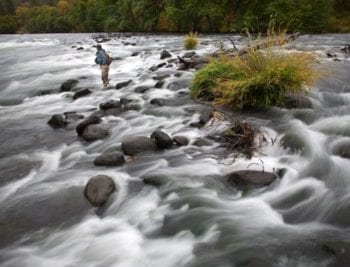2013 Pit River Anglers Satisfied With Catch Rates, Size, and Overall Experience
A three year angler survey conducted by Spring Rivers Ecological Sciences on behalf of PG&E suggests that the Pit River remains one of the best wild trout fisheries in northern California.
PG&E’s federal hydropower license requires them to monitor annual fishing results and angler satisfaction in the Pit 3, 4, 5 reaches.
The 100 plus page report, titled Pit 3, 4, and 5 River Fish Monitoring Plan: 2013 Angler Survey Report, surveyed 131 fisherman last season and found that anglers remain satisfied with the “overall fishing experience.” Anglers commented that higher flows do limit previously accessible waters, but the fishing remains above average.
According to the report, “Positive Angler Satisfaction Ratings,” catch rates, size, and overall experience have actually improved slightly in all reaches each consecutive year since the surveys began in 2011.” Additionally, “During the 2011, 2012, and 2013 season, the substantial majority of anglers (>73%) in all three reaches indicated that despite higher flows, they would return and fish the same reach again.”
 Guide satisfaction appears to be a different story. “Guides surveyed for the report indicated that the angling experience for their clients had decreased from the previous year in each of the three survey years.” The majority of guides indicated that the percent of clients capable of fishing the Pit River has decreased each year due to high flows and limited accessibility.
Guide satisfaction appears to be a different story. “Guides surveyed for the report indicated that the angling experience for their clients had decreased from the previous year in each of the three survey years.” The majority of guides indicated that the percent of clients capable of fishing the Pit River has decreased each year due to high flows and limited accessibility.
As part of their license, PG&E is also required to conduct numerous other annual monitoring reports that include River Fish, Gravel Augmentation, Macroinvertebrates, and Water Quality and Temperature.
Key highlights from these reports are listed below:
- Pit River rainbow trout in 2013 exhibit length-at-age estimates that equal or exceed most other northern CA populations reported in scientific literature
- 2013 trout condition factors remain among highest observed when compared with data from nearby rivers, indicating that Pit River trout are robust and healthy
- 33 days last season anglers experienced flows that were 2-3 times higher than normal (over 800 cfs) due to power outages and experimental whitewater flows
- Average biomass of rainbow trout was highest in Pit 3 (9 lbs. per acre) and declined in downstream reaches
- Catch rates were highest in Pit 3 Reach (2.2 trout per hour per angler) and lowest in Pit 5 (1.3 trout per angler)
To browse the reports, please visit the “Pit 3,4,5 License Implementation Website” set up by PG&E.
For a brief history of the Pit and its flows and what it means for fishermen, check out the video CalTrout produced last year, How to Fish the Pit River’s New Flows.
[youtube]https://www.youtube.com/watch?v=F-je2ioZBvk[/youtube]





5 Comments
WOW just what I was looking for. Came here by searching for pit river
Whom did this survey talk to. Were they all 20 somethings?.. The river has always been a good producer of quality fish. The issue with the higher flows is it is restricting access to all but the most able bodied, thus skewing the outcome of the survey.. If they talked to my piers I would think the response would have been different.. I am not an old geezer complaining, just an average middle age fisher person who used to enjoy fishing he Pit. And now finds himself if it is worth the chance of getting in trouble in the pursuit of one of the more beautiful trout in the state.
Heck, I’m 60 and still loving the Pit!
I fished Pit 3 last year and it was excellent, but aggressive wading is required. I enjoy aggressive wading, but there’s no doubt that the higher flows have reduced access, especially in Pit 4 & 5. Here’s my question. What’s the actual benefit of the higher flows.The frog water is still frog water and the pocket water is still pocket water. Is there any evidence that the number or health of trout has been improved? Pocket water in Pit 3,4,5 was loaded with fat trout 5 years ago. Is it any better today?
Also, I thought I heard that kayakers were somehow involved with the higher flows. Maybe this is incorrect, but if not, how many kayakers are benefitting from higher flows. I only fish the Pit a few times each year, but I’ve never seen a kayaker there.
Good job, Cal Trout. More water means increased and enhanced (colder) habitat for fish – and bugs, birds, animals, etc. It’s always been hard to fish. I’ve swum in it every time I’ve fished it. But I never see other anglers and that is increasingly rare anyplace you go now, not just California.